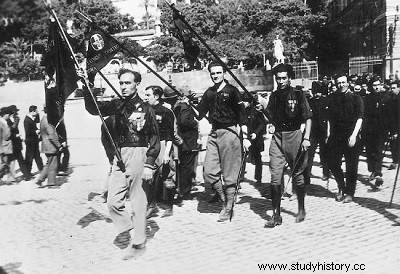
Twenty-four hours later, the Popular Front government resigned. Various other political combinations were sketched out, but no central authority capable of organizing resistance emerged. On the contrary, some left-wing extremist elements tried to respond to the rebellion with revolution. deploying as much ardor in opposing each other as they put in fighting the rebels. Deeply divided from the start, the power in place was doomed to fail if it failed to overcome its internal differences.
General Mola, who had promoted himself to general army from the start of the civil war, encountered more difficulties than expected in seizing the monarchist province of Navarre and launching his four columns in the direction of Madrid where, as he claimed, a fifth was soon to be to help. General Franco had reached Morocco by plane and succeeded in taking command of the African army, 25,000 strong.
But then he ran into a major obstacle:the naval crews had mutinied against their pro-rebellion officers and seized the ships; thus, Franco found himself without means of transport to bring his army to Spanish soil through the Strait of Gibraltar.
However, the rebels. or nationalists as they were now called, had appealed to Germany and Italy. Hitler and Mussolini, both very satisfied with this request, immediately gave them their support and provided them with assistance that would continue to grow throughout the war.
Hitler gave several reasons for his intervention. He wanted to divert the attention of the Western powers to Spain so that German rearmament could continue quietly and he needed Spanish iron ore, which only a Nationalist government would agree to supply. Furthermore, strategically, a nationalist success would establish a right-wing or semi-fascist state at the entrance to the Mediterranean and would constitute a potential obstacle to the maritime communications of Britain and France.
As for Mussolini, he aspired to dominate the Mediterranean, an ambition that would be supported by a right-wing Spanish government. The existence of such a government could also lead France to withdraw troops from the Italian border and, if war between France and Italy were to break out, hamper the transport of French troops from Morocco to the metropolis.
Moreover, from an ideological point of view, the two dictators were obviously fiercely opposed to a communist Spain; this was one more reason to intervene, closely linked to strategic considerations.
So the Italians and Germans responded favorably to Franco's request and provided him with transport planes. If it had been otherwise, it is highly unlikely that the elite troops of the African army would have been able to land in Andalusia in time and outrun the government forces.
The advance of Mola's forces marching on Madrid from the north and northwest and the landing of Franco's army in the south made it clear that the battle for the capture of the capital was now only a matter of hours. But, in the capital itself, the rebels' plans had failed. According to the plan of the U.M.E., General Villegas was to leave the Montana barracks at dawn on Saturday, July 18, under the pretext of restoring order and law, and occupy the ministries, the radio, the newspaper headquarters, the railway station and the airport.
As the outcome of the uprising was uncertain, Villegas waited another day, then decided that the task was beyond his strength. His successor, General Joaquim Fanjul, did try to carry out the initial plan, but thousands of Madrilenians, armed in haste with pistols, rifles, pickaxes or axes, rushed into the barracks and massacred almost everyone who got there. found. Madrid remained in government hands and it was a severe disappointment for the Nationalists, who had hoped for a quick victory.
Two weeks later, the supreme command of the nationalists, the “Junta de la Defence”, recognized two armies:that of Franco in the south and that of Mola in the north. Well supplied with weapons, ammunition, bombs, transport vehicles and fuel by Germany and Italy as well as by American private companies, Franco's forces were able to move quickly from the north of Cadiz to Merida where they made their junction with Mola's army. Franco then secured his rear by crushing the government forces holding Badajoz, then turned northeast towards Madrid.
On September 3, Franco's forces invested Talavera de La Reina, 116 kilometers from Madrid. The danger to the capital was sufficiently obvious that the most important "republican armed groups", as the government in place called them, finally agreed to defend the city.
A month later , after having continued its progress and freed the Alcazar of Toledo besieged by the Republicans. Franco was proclaimed Head of State and Commander-in-Chief of the Land, Sea and Air Armies. On the Republican side, the new leader was the head of the National Workers' Union. Francisco Largo Caballero, labor leader and politician of eminent qualities but profoundly ignorant of military questions. After its defeat at Toledo, the Republican Militia had collapsed in the greatest confusion and the gates of Madrid seemed open. The Nationalists announced that the capital would fall into their hands on October 12, and General Mola even boasted that he could have coffee that day in a famous establishment on Gran Via.
